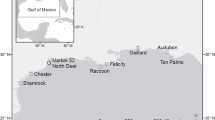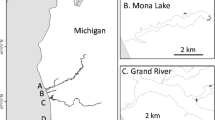Abstract
Quartz Hill, in Misty Fjords National Monument near Ketchikan, Alaska, is the site of a proposed molybdenum-producing mine. To provide baseline data for use in post-development comparisons, we analyzed tissues of Barrow's goldeneyes (Bucephala islandica), common mergansers (Mergus merganser), and blue mussels (Mytilus edulis) for seven heavy metals that could potentially be released into the environment as a result of mining operations. Specimens were collected in 1980, 1981, and 1982 from two fjords likely to be used for discharge of tailings from the proposed mine and from two control fjords. Concentrations of arsenic, cadmium, copper, chromium, molybdenum, lead, and zinc were measured in soft tissues of mussels and in kidney, liver, and muscle of birds. The highest mean concentrations of metals found in bird tissues were 55.7 ppm dry weight cadmium in kidneys and 154 ppm dry weight zinc in livers of Barrow's goldeneyes. Concentrations of several metals in blue mussels differed among seasons and locations, but the most significant finding in mussels was a maximum mean cadmium concentration of 9.6 ppm dry weight, a level higher than normally found in undisturbed areas. With the exception of 104 ppm dry weight cadmium in the kidney of one common merganser and 12.7 ppm dry weight lead in the kidney of another, concentrations of other metals in seaduck and mussel tissues were low, consistent with what would be expected for a pre-development environment. Molybdenum was found in low concentrations (<10 ppm dry weight) in all avian kidney samples and most liver samples, but was not detected in blue mussels.
Similar content being viewed by others
References
Adrian, W. J. and Stevens, M. L.: 1979, ‘Wet Versus Dry Weights for Heavy Metal Toxicity Determinations in Duck Liver’, J. Wildl. Dis. 15, 125–126.
Bellrose, F. C.: 1980, Ducks, Geese and Swans of North America, 3rd edn. Stackpole Books, Harrisburg, PA, pp. 540.
Bull, K. R., Murton, R. K., Osborn, D., Ward, P., and Cheng, L.: 1977, ‘High Levels of Cadmium in Atlantic Seabirds and Sea-Skaters’, Nature 269, 507–509.
Chipperfield, P. N. J.: 1953, ‘Observations on the Breeding and Settlement of Mytilus edulis (L.) in British Waters’, J. Mar. Biol. Assoc. U.K. (32), 449–476.
Clements, J. F.: 1991, Birds of the World: A Check List, Ibis Publ. Co., Vista, CA, pp. 617.
Di Giulio, R. T. and Scanlon, P. F.: 1984a, ‘Effects of Cadmium and Lead Ingestion on Tissue Concentrations of Cadmium, Lead, Copper, and Zinc in Mallard Ducks’, Sci. Total Environ. 39, 103–110.
Di Giulio, R. T. and Scanlon, P. F.: 1984b, ‘Heavy Metals in Tissues of Waterfowl from the Chesapeake Bay, USA’, Environ. Pollut. (Ser. A) 35, 29–48.
Di Giulio, R. T. and Scanlon, P. F.: 1985, ‘Heavy Metals in Aquatic Plants, Clams, and Sediments from the Chesapeake Bay, U.S.A. Implications for Waterfowl’, Sci. Total Environ. 41, 259–274.
Eisler, R.: 1985, ‘Cadmium Hazards to Fish, Wildlife, and Invertebrates: A Synoptic Review’, U.S. Fish Wildl. Serv. Biol. Rep. 85(1.2), pp. 46.
Eisler, R.: 1993, ‘Zinc Hazards to Fish, Wildlife, and Invertebrates: A Synoptic Review’, U.S. Fish Wildl. Serv. Biol. Rep. 10, pp. 106.
Elliot, S. T.: 1980, ‘Baseline Biological Investigation of Aquatic Macrobenthos and Juvenile Salmonids in Relation to the Proposed U.S. Borax Molybdenum Mine near the Keta and Blossom Rivers. 1978–1979’, Special Report, Alaska Dept. Fish and Game, Sport Fish Div., Juneau, AK, pp. 48.
Eriksson, M. O. G., Henrikson, L, and Oscarson, H. G.: 1989, ‘Metal Contents in Liver Tissues of Non-Fledged Goldeneye, Bucephala clangula, Ducklings: A Comparison Between Samples from Acidic, Circumneutral, and Limed Lakes in South Sweden’, Arch. Environ. Contam. Toxicol. 18, 255–260.
Franson, J. C.: 1984, ‘Postmortem Changes in Liver Weight of Japanese Quail’, Bull. Environ. Contam. Toxicol. 33, 313–316.
Goyette, D. and Nelson, H.: 1977, ‘Marine Environmental Assessment of Mine Waste Disposal into Rupert Inlet, British Columbia’, Surveillance Report EPS PR-77-11, Environmental Protection Service, Environment Canada, Pacific Region, West Vancouver, British Columbia, pp. 93.
Haseltine, S. D., Heinz, G. H., Reichel, W. L., and Moore, J. F.: 1981, ‘Organochlorine and Metal Residues in Eggs of Waterfowl Nesting on Island in Lake Michigan off Door County, Wisconsin, 1977–78’, Pestic. Monit. J. 15, 90–97.
Hulse, M., Mahoney, J. S., Schroder, G. D., Hacker, C. S., and Pier, S. M.: 1980, ‘Environmentally Acquired Lead, Cadmium, and Manganese in the Cattle Egret, Bubulcus ibis, and the Laughing Gull, Larus atricilla’, Arch. Environ. Contam. Toxicol. 9, 65–78.
Hutton, M.: 1981, ‘Accumulation of Heavy Metals and Selenium in Three Seabird Species from the United Kingdom’, Environ. Pollut. (Ser. A) 26, 129–145.
Koehl, P. S., Rothe, T. C., and Derksen, D. V.: 1984, ‘Winter Food Habits of Barrow's Goldeneyes in Southeast Alaska’, in: Nettleship, D. N., Sanger, G. A. Springer, P. F. (Eds.), Marine Birds: Their Feeding Ecology and Commercial Fisheries Relationships, Canadian Wildl. Serv. Spec. Pub., Ottawa, Ontario, pp. 1–5.
Lande, E.: 1977, ‘Heavy Metal Pollution in Trondheimsfjorden, Norway, and the Recorded Effects on the Fauna and Flora’, Environ. Pollut. 12, 187–198.
McGreer, E. R., Reid, B. J., and Vigers, G. A.: 1980, ‘Availability of Metals from Inorganic Particulates (Mine Tailings) for Uptake by Marine Invertebrates’, Dept. Fisheries and Oceans, West Vancouver Lab., West Vancouver, British Columbia, Project 646, E. V. S. Consultants, Ltd., North Vancouver, British Columbia, pp. 30.
National Research Council: 1980, ‘The International Mussel Watch-Report of a Workshop Sponsored by the Environmental Studies Board, Commission on Natural Resources’, National Academy of Sciences, Washington, DC, pp. 248.
Neter, J. and Wasserman, W.: 1974, Applied Linear Statistical Models, R.D. Irwin. Inc., Homewood, Il, pp. 842.
Norheim, G.: 1987, ‘Levels and Interactions of Heavy Metals in Sea Birds from Svalbard and the Antarctic’, Environ. Pollut. 47, 83–94.
Ohlendorf, H. M., Lowe, R. W., Kelly, P. R., and Harvey, T. E.: 1986, ‘Selenium and Heavy Metals in San Francisco Bay Diving Ducks’, J. Wildl. Manage. 50, 64–71.
Ouellette, T. R.: 1981, ‘Seasonal Variation of Trace-Metals in the Mussel Mytilus californianus’, Environ. Cons. 8, 53–58.
Parslow, J. L. F., Thomas, G. J., and Williams, T. D.: 1982, ‘Heavy Metals in the Livers of Waterfowl from the Ouse Washes, England’, Environ. Pollut. (Ser. A) 29, 317–327.
Phillips, D. J. H.: 1976, ‘The Common Mussel Mytilus edulis as an Indicator of Pollution by Zinc, Cadmium, Lead and Copper. I. Effects of Environmental Variables on Uptake of Metals’, Mar. Biol. 38, 59–69.
Phillips, D. J. H.: 1979, ‘Trace Metals in the Common Mussel, Mytilus edulis (L.), and in the Alga Fucus vesiculosus (L.) from the Region of the Sound (Oresund)’, Environ. Pollut. 18, 31–43.
Popham, J. D. and D'Auria, J. M.: 1982, ‘Effects of Season and Seawater Concentrations on Trace Metal Concentrations in Organs of Mytilus edulis’, Arch. Environ. Contam. Toxicol. 11, 273–282.
Scanlon, P. F.: 1982, ‘Wet and Dry Weight Relationships of Mallard (Anas platyrhynchos) Tissues’, Bull. Environ. Contam. Toxicol. 29, 615–617.
Schulz-Baldes, M.: 1974, ‘Lead Uptake from Sea-Water and Food, and Lead Loss in the Common Mussel Mytilus edulis’, Mar. Biol. 25, 177–193.
Seed, R.: 1976, ‘Ecology’, in Bayne, B. L. (Ed.), Marine Mussels: Their Ecology and Physiology, Cambridge University Press, Cambridge, UK. pp. 13–65.
Simpson, R. D.: 1979, ‘Uptake and Loss of Zinc and Lead by Mussels (Mytilus edulis) and Relationships with Body Weight and Reproductive Cycle’, Marine Poll. Bull. 10, 74–78.
Szefer, P. and Falandysz, J.: 1987, ‘Trace Metals in the Soft Tissues of Scaup Ducks (Aythya marila L.) Wintering in Gdańsk Bay, Baltic Sea’, Sci. Total Environ. 65, 203–213.
Turner, J. C., Solly, S. R. B., Mol-Krijnen, J. C. M., and Shanks, V.: 1978, ‘Organochlorine, Fluorine, and Heavy-Metal Levels in some Birds from New Zealand Estuaries’, New Zealand J. Sci. 21, 99–102.
USDA Forest Service: 1988, ‘Final Environmental Impact Statement: Quartz Hill Molybdenum Project Mine Development’, USDA-FS-R10-MB-41a, Misty Fjords National Monument, Tongass National Forest, Alaska.
Vermeer, K. and Peakall, D. B.: 1979, ‘Trace metals in Seaducks of the Fraser River Delta Intertidal Area, British Columbia’, Mar. Pollut. Bull. 10, 189–193.
VTN Consolidated, Inc: 1983, ‘Terrestrial Vegetation and Wildlife Technical Memorandum for the Proposed Quartz Hill Molybdenum Project, Southeast Alaska’, U.S. Borax and Chemical Corporation, Unpublished.
White, D. H. and Finley, M. T.: 1978a, ‘Effects of Dietary Cadmium in Mallard Ducks’, in: Hemphill, D. D. (Ed.), Trace Substances in Environmental Health-XII, University of Missouri, Columbia, pp. 220–223.
White, D. H. and Finley, M. T.: 1978b, ‘Uptake and Retention of Dietary Cadmium in Mallard Ducks’, Environ. Res. 17, 53–59.
White, D. H., Stendell, R. C., and Mulhern, B. M.: 1979, ‘Relations of Wintering Canvasbacks to Environmental Pollutants-Chesapeake Bay, Maryland’, Wilson Bull. 91, 279–287.
White, D. H., and Kaiser, T. E.: 1976, ‘Residues of Organochlorines and Heavy Metals in Ruddy Ducks from the Delaware River, 1973’, Pestic. Monit. J. 9, 155–156.
Zar, J. H.: 1984, Biostatistical Analysis, 2nd edn, Prentice-Hall, Inc., Englewood Cliffs, NJ, pp. 718.
Author information
Authors and Affiliations
Additional information
THE U.S. GOVERNMENT RIGHT TO RETAIN A NON-EXCLUSIVE, ROYALTY FREE LICENCE IN AND TO ANY COPYRIGHT IS ACKNOWLEDGED.
Rights and permissions
About this article
Cite this article
Franson, J.C., Koehl, P.S., Derksen, D.V. et al. Heavy metals in seaducks and mussels from misty fjords national monument in Southeast Alaska. Environ Monit Assess 36, 149–167 (1995). https://doi.org/10.1007/BF00546787
Received:
Revised:
Issue Date:
DOI: https://doi.org/10.1007/BF00546787




